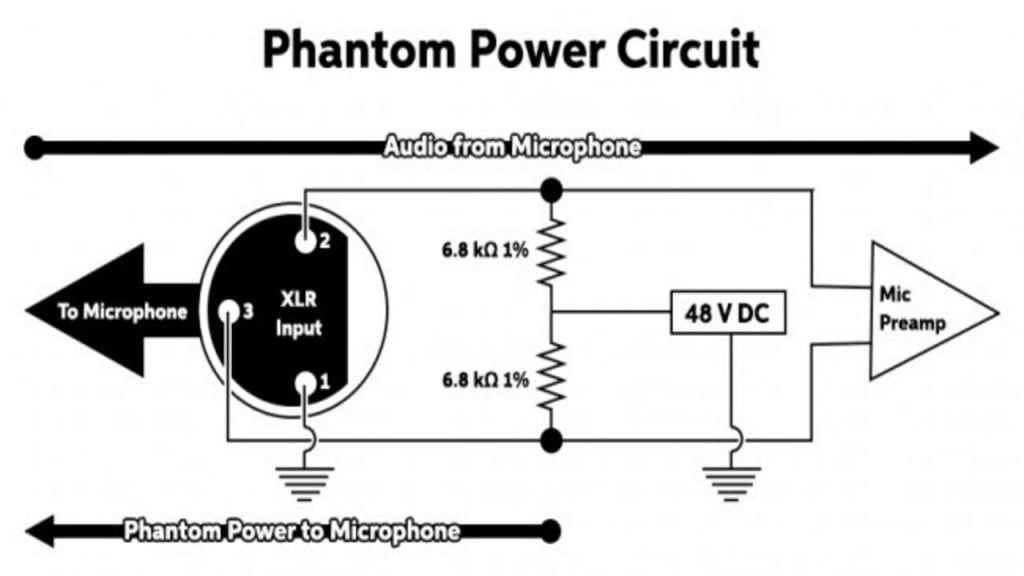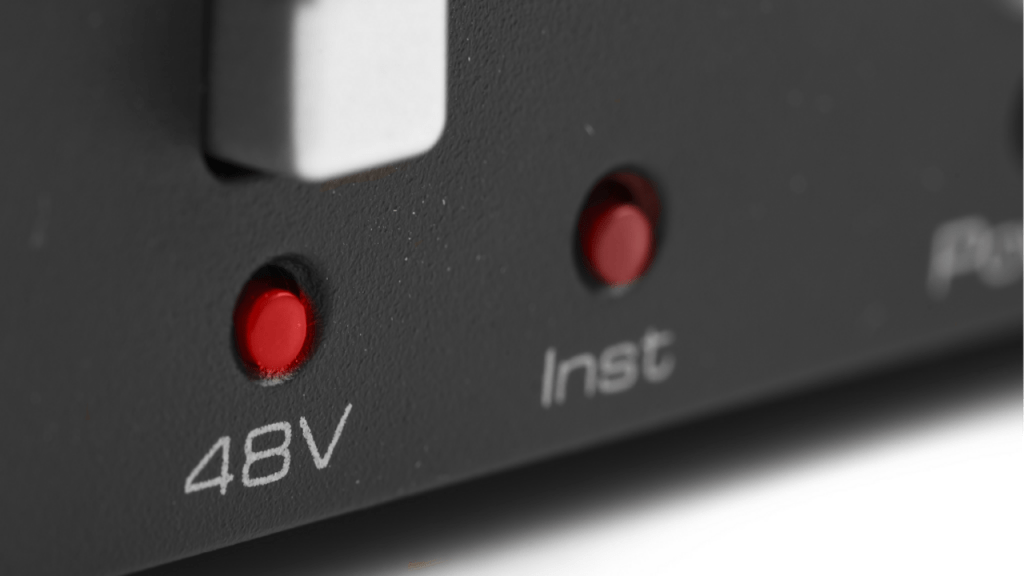Phantom power is an electrical signal sent to a microphone or other sound-input device before it’s turned on. Without this “phantom” power, many devices would be unusable at all but very short distances from their intended source.
The reason for the phantom power pre-amplification circuit is to compensate for voltage loss in long cables and connectors, which can drop below the noise floor of typical audio circuitry if not amplified beforehand.
In this blog, I’ll explain what does phantom power do? where it can be used, and why we need it?
What Is Phantom Power?
Phantom power is the “phantom” voltage that powers electret, condenser, and some ribbon microphones. It’s called phantom because it goes down the microphone cable to power mics plugged into an input on a mixing board instead of needing batteries or other external power.
Phantom power supplies electricity to the microphone through the cable that carries the signal from it back to the mixing board. The mixer itself gets its electrical power from a wall outlet and sends a little bit of that power down the cable to whatever device is plugged into an input on its channel strip, usually with a preamp circuit attached to the output.
Phantom power is necessary because microphones would generally not work without them, and conventional passive mics need it. Phantom power is the same DC voltage as batteries, but it comes directly from the mixer or preamp.
How Does Phantom Power Work?

To supply power to an active or phantom-powered device, a voltage of 12-48V DC must be provided. The exact value of the supply voltage depends on the specific mic that is to be used.
The voltage from the phantom power supply is applied through a capacitor in series with a resistor to the signal connection of the microphone. DC flows from the power supply through this capacitor and resistor.
Phantom power is a method of supplying electrical power to a condenser microphone. Condenser microphones require a power source to operate, and many use one AAA or AA size battery as this power source.
Advantages of Phantom Power?
- Provides power to microphones and other equipment through microphone cable.
- Phantom power is a must for condenser mics – typical examples are large-diaphragm tube condenser microphones.
- Phantom power is used to power the active components of active microphones.
- The way condenser mics work, their output is very high impedance, and therefore requires a powered circuit to reduce that impedance.
Most microphones will work without phantom power, but their performance will be severely degraded (or even unusable) if connected to an external power source. Condenser microphones require a high voltage; typically 48V; the exact value depends on the specific microphone.
Phantom power is needed for condenser microphones because their diaphragms need a high voltage to stay charged. The voltage is supplied via the cable that carries the electrical signal back to the mixing desk or preamp.
What Does Phantom Power Do ?

Phantom power is the same as a battery inside a condenser microphone, but instead of using a battery, it gets its power from the mixer or preamp. It provides electricity to the mic through a capacitor and resistor.
Phantom power is needed for condenser mics because their diaphragms need a high voltage to stay charged. The voltage is supplied via the cable that carries the electrical signal back to the mixing desk or preamp.
Without phantom power, the signal will be much weaker and, in some cases, unusable. Phantom power is supplied to microphones through the microphone’s XLR cable. The energy travels down the same wire that carries the audio signal (usually pin 2 for mic-in).
Why Do I Need Phantom Power In Microphone?
Phantom power is needed for condenser mics because their diaphragms need a high voltage to stay charged. The voltage is supplied via the cable that carries the electrical signal back to the mixing desk or preamp.
One of the most important things to remember about phantom power is applied equally to both audio channels. In addition, because condenser microphones are engineered for phantom power, it is safe to use them with any typical mixer.
Phantom power can be helpful in many applications, especially when you need to connect a condenser mic that does not have its built-in power supply. Condenser microphones require a high voltage to operate correctly, and phantom power supplies the necessary voltage.
FAQ’s (Frequently Asked Questions)
What happens if you don’t use phantom power?
As sound waves hit the polarized capsule it converts them into an electrical signal. So, without phantom power, the diaphragm is not polarized, and you don’t have the electric field required. A dynamic mic, which is the other most common mic doesn’t use the same mechanism.
Does phantom power matter?
Phantom power is a complex subject, but for most of us, it’s a matter of matching the requirements of our mics—or other gear—with the features of the mixer. … Some ribbon mics (usually used only in studios) can be damaged by phantom power if a cable or the mic is mis-wired.
How do I know if my mic needs phantom power?
Well, the simplest way would be to verify whether your microphone is a condenser type or another type such as dynamic or ribbon. If it is a condenser microphone it will need phantom power, if it is a different type of microphone it will not.
Does phantom power improve sound quality?
Phantom power simply supplies a condenser microphone with additional voltage. Phantom power, therefore, does not reduce noise, but it does provide the microphone with the necessary boost in power that it needs to record audio. Noise is more likely to be reduced by taking other measures.
Does phantom power hurt dynamic mics?
Phantom power is a dc voltage (11 – 48 volts) that powers the preamplifier of a condenser microphone. … A balanced dynamic microphone is not affected by phantom power; however, an unbalanced dynamic microphone will be affected. Although the microphone will probably not be damaged, it will not work properly.
Conclusion
Phantom power is the flow of electricity to electronic devices, even when they are turned off. (The term ‘phantom’ refers to the fact that there is no physical connection between source and load.)
This means that electronic devices, such as a microphone (which requires phantom power), can be plugged into an audio mixer attached to the mixing board, even though they are turned off.
Until then check out some of my other articles too:
What Is Vocal Booth? How To Build A Vocal Booth?
What Is a Tube Microphone? Explained In Detail
What Is A Shotgun Microphone? When To Use? Pros And Cons
What Is Microphone Array? Explained In Detail
What Is Polar Pattern? Types Of Polar Patterns
